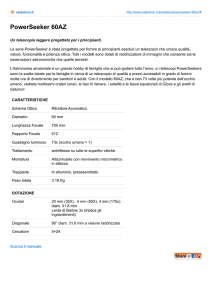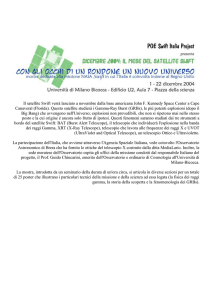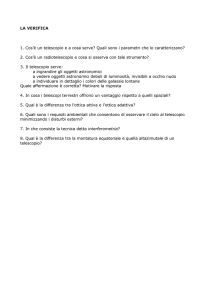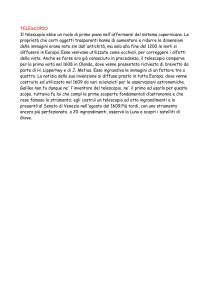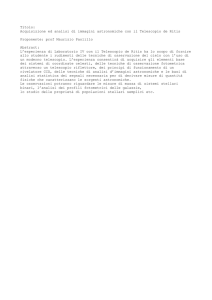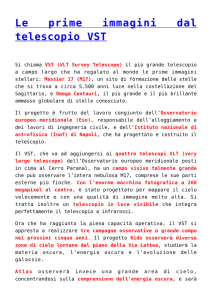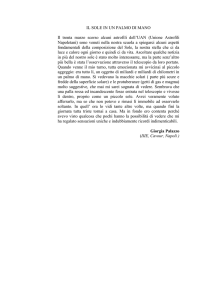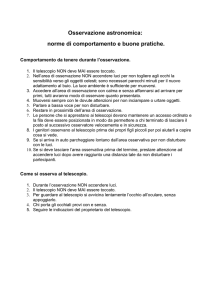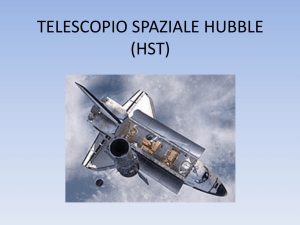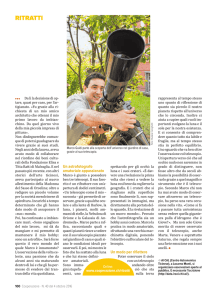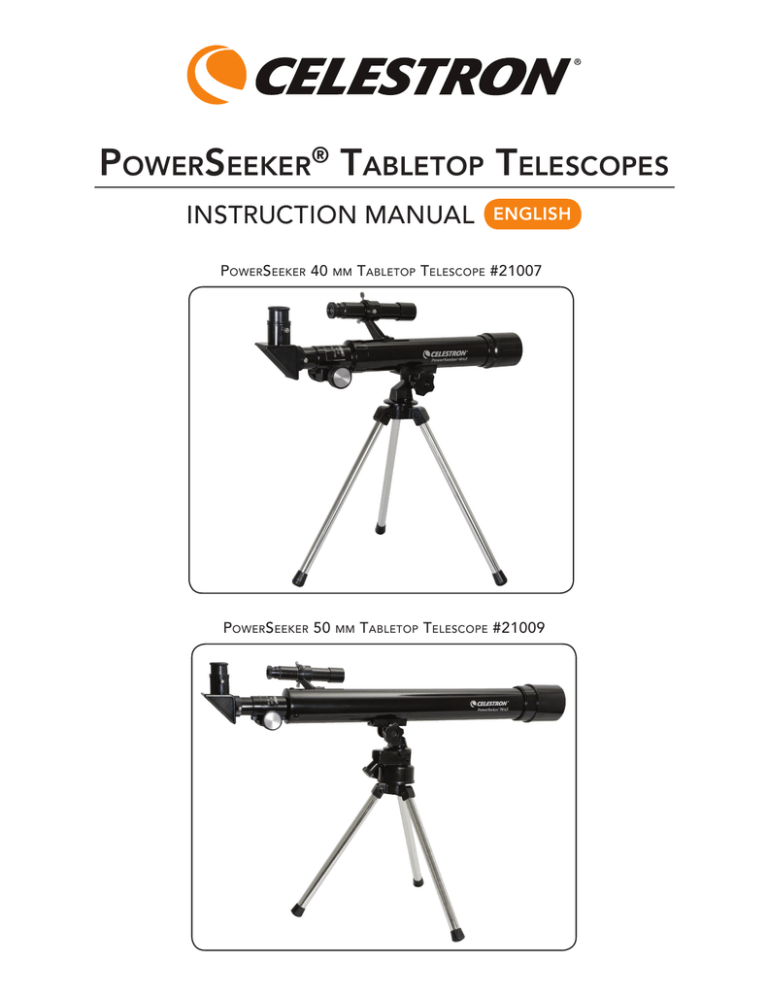
PowerSeeker® Tabletop Telescopes
Instruction Manual
English
PowerSeeker 40
mm
Tabletop Telescope #21007
PowerSeeker 50
mm
Tabletop Telescope #21009
Table of Contents
INTRODUCTION. . . . . . . . . . . . . . . . . . . . . . . . . . . . . . . . . . . . . . . . . . . . . . . . . . . . . . . . . . . . . . . . . . . . . . . . . . . . 3
ASSEMBLY.. . . . . . . . . . . . . . . . . . . . . . . . . . . . . . . . . . . . . . . . . . . . . . . . . . . . . . . . . . . . . . . . . . . . . . . . . . . . . . . . . 5
SETTING UP THE TRIPOD.. . . . . . . . . . . . . . . . . . . . . . . . . . . . . . . . . . . . . . . . . . . . . . . . . . . . . . . . . . . . . . . . . . . . . . . . . 5
ATTACHING THE TELESCOPE OPTICAL TUBE TO THE TRIPOD. . . . . . . . . . . . . . . . . . . . . . . . . . . . . . . . . . . . . . 5
MOVING THE TELESCOPE MANUALLY.. . . . . . . . . . . . . . . . . . . . . . . . . . . . . . . . . . . . . . . . . . . . . . . . . . . . . . . . . . . . 6
INSTALLING THE STAR DIAGONAL & EYEPIECE.. . . . . . . . . . . . . . . . . . . . . . . . . . . . . . . . . . . . . . . . . . . . . . . . . . . . 6
INSTALLING & USING THE BARLOW LENS.. . . . . . . . . . . . . . . . . . . . . . . . . . . . . . . . . . . . . . . . . . . . . . . . . . . . . . . . . 7
INSTALLING & USING THE 1.5X ERECTING EYEPIECE.. . . . . . . . . . . . . . . . . . . . . . . . . . . . . . . . . . . . . . . . . . . . . . 7
ALIGNING THE FINDERSCOPE.. . . . . . . . . . . . . . . . . . . . . . . . . . . . . . . . . . . . . . . . . . . . . . . . . . . . . . . . . . . . . . . . . . . . 7
Additional Information
Reference material on Telescope Basics, Astronomy
Basics, Celestial Observing, and Telescope
Maintenance can be found on the Celestron website
2
www.celestron.com under your product model in the
support section. Detailed specifications can be found
in the Specs section.
Introduction
Congratulations on your purchase of a PowerSeeker
telescope. The PowerSeeker Series is made of the highest
quality materials to ensure stability and durability. All this
adds up to a telescope that gives you a lifetime of pleasure
with a minimal amount of maintenance.
Take time to read through this manual before embarking
on your journey through the Universe. It may take a few
observing sessions to become familiar with your telescope,
so you should keep this manual handy until you have fully
mastered your telescope’s operation.
These telescopes were designed for the First Time Buyer
offering exceptional value. The PowerSeeker series
features a compact and portable design with ample optical
performance to excite newcomers to the world of amateur
astronomy. In addition, your PowerSeeker telescope is
ideal for terrestrial observations which will open your eyes
to the world around you with its high power viewing.
Your telescope is designed to give you years of fun and
rewarding observations. However, there are a few things to
consider before using your telescope that will ensure your
safety and protect your equipment.
PowerSeeker telescopes carry a two year limited warranty.
For details see our website at www.celestron.com.
Some of the many standard features of the PowerSeeker include:
• All coated optical elements and fully coated objective lens for
clear, crisp images.
• All metal telescope optical tube
• Smooth functioning, rigid altazimuth (tripod) mount with easy
pointing to located objects.
• Preassembled aluminum tripod ensures a stable platform.
• Quick and easy no-tool set up.
• CD-ROM “The SkyX” -- astronomy software which provides
education about the sky and printable sky maps.
• All models can be used terrestrially as well as astronomically
with the standard accessories included.
Warning
•Never look directly at the Sun with the naked eye or with a telescope (unless you have the proper solar filter). Permanent and irreversible eye damage may result.
•Never use your telescope to project an image of the sun onto any surface. Internal heat build-up can damage the telescope and any accessories attached to it.
•Never use an eyepiece solar filter or a Herschel wedge. Internal heat build-
up inside the telescope can cause these devices to crack or break, allowing unfiltered sunlight to pass through to the eye.
•Do not leave the telescope unsupervised, either when children are present or adults who may not be familiar with the correct operating procedures of your telescope.
3
4
3
2
7
5
1
10
9
6
11
8
Figure 1 PowerSeeker 50 mm Tabletop Telescope
(PowerSeeker 40 mm Tabletop Telescope Similar)
1Objective Lens
2Telescope Optical Tube
3 Finderscope
4 Eyepiece
5 Diagonal
6 Focus Knob
7Altitude Locking Knob
8Tripod
9 Azimuth Knob (not on 40 mm)
10Tripod Head
11Altitude Fine Adjustment Knob (not on 40 mm)
4
Assembly
Figure 2
This section covers the assembly instructions for your PowerSeeker
telescope. Your telescope should be set up indoor the first time so
that it is easy to identify the various parts and familiarize yourself with
the correct assembly procedure before attempting it outdoor.
Each PowerSeeker comes in one box. The pieces in the box are
(Figure 2) – telescope optical tube with finderscope attached, tripod
(altazimuth mount), star diagonal, 20 mm eyepiece, 8 mm eyepiece,
2x Barlow lens, 1.5x erecting eyepiece, “The SkyX” CD-ROM, and a
nylon carrying bag.
Setting up the Tripod
1.Remove the tripod from the box (Figure 2). The tripod comes preassembled so that the set up is very easy. Each tripod is different for each model but looks somewhat similar to the photos shown (Figure 3).
2.Stand the tripod upright and pull the tripod legs apart until each leg is fully extended. The very top of the tripod is called the head (altazimuth mount).
3.The tripod is now completely assembled (Figure 4).
Figure 3
Figure 4
Attaching the Telescope Optical Tube to the Tripod
The telescope optical tube attaches to the tripod
(altazimuth mount). Follow the steps below:
1.Remove the protective paper or plastic bag covering
the optical tube.
2.Remove the altitude locking knob from the telescope
optical tube – see center of Figure 5.
3.Place the telescope optical tube on the tripod
(altazimuth) mount so that the hole in the top of the
optical tube platform lines up with the hole in the
mount head – see Figure 6.
4.Insert the altitude locking knob through the tripod
mount head and optical tube platform (make sure the hole is clear all the way through before tightening the knob). The knob screw will thread into the insert and then tighten it. Figure 7 shows the optical tube attached to the tripod.
5.Remove the lens cover from the large end of
the telescope.
Figure 5
Figure 6
Figure 7
5
Moving the Telescope Manually
The PowerSeeker 50 mm tabletop telescope is easy to move
wherever you want to point it.
1.The up and down (altitude or vertical) is controlled by
the altitude locking knob (Figure 7). The knob can
tighten the altitude so it cannot move but normally it
should be slightly loose so you can move the telescope
up or down slowly. The best way to move the telescope
up and down is to have one hand on the tripod head
and the other hand on the diagonal and move it to
where you want.
2.You can make fine adjustments in altitude by using the altitude fine adjustment knob – Figure 9. Turn the knob in either direction for finite movement when the altitude
locking knob is tightened.
3.The side-to-side (azimuth or horizontal movement)
is controlled by the azimuth knob (Figure 8). A small
thumbscrew to the left of the azimuth knob locks the
azimuth movement. When you loosen the thumbscrew,
you can then move the telescope freely in azimuth by turning the azimuth knob. Alternately, you can move the telescope in azimuth (when the thumbscrew is loosened)
Figure 8
by placing one hand on the tripod head and the other hand on the diagonal and move it to where you want.
4.When both knobs (altitude and azimuth) are loose you can find your objects easily (through the finderscope) and then tighten the knobs when the object is centered.
The PowerSeeker 40 mm tabletop telescope is easy to move
wherever you want to point it.
1. The altitude (up/down or vertical) movement is controlled solely by loosening the altitude locking knob and then tighten it slightly for small movements – Figure 10.
2.The azimuth (side-to-side or horizontal) movement does
not have a lock knob and freely moves whenever you
want to move it.
3.The easiest way to move the telescope around to find
an object you are looking for is to hold the tripod head with one hand and hold the diagonal with the other hand and then move the telescope as you desire.
Note: Before tightening the altitude locking knob, the location you are seeking should be located in the
finderscope.
Figure 9
Figure 10
Installing the Star Diagonal and Eyepiece
The star diagonal is a prism that diverts the light at a right
angle to the light path of the telescope. This allows you
to observe in a position that is more comfortable than if
you had to look straight through. Also, the diagonal can
be rotated to any position which is most favorable for you.
The star diagonal corrects the image to be right side up
(erect image) but the image is reversed left-to-right. To
install the diagonal and eyepiece:
1.Insert the small barrel of the diagonal into the eyepiece
3. The eyepieces can be changed to different powers by
adapter of the focus tube on the small end of the
reversing the procedure in step 2 above.
telescope optical tube – Figure 12. Make sure the
Figure 12
Figure 11
thumbscrew on the eyepiece adapter does not protrude
into the focuser tube before installation and the plug up
caps are removed from the eyepiece adapter.
2.Put the small barrel end of one of the eyepieces into the diagonal and tighten the thumb screw – Figure 11.
Again, when doing this make sure the thumbscrew is not protruding into the diagonal before inserting the eyepiece and remove all caps.
6
Installing and Using the Barlow Lens
Your telescope comes with a 2x Barlow Lens which doubles
the magnifying power of each eyepiece. However, the
greatly magnified images should only be used under
ideal conditions.
To use the Barlow lens, remove the diagonal and insert
the Barlow directly into the focuser tube – Figure 13 after
removing all caps. You then insert an eyepiece into the
Barlow lens for viewing. You can also, insert the diagonal
into the Barlow lens and then use an eyepiece in the
diagonal but you may not be able to reach focus with
all eyepieces.
Note: Start by using a low power eyepiece as it will be
easier to focus.
Figure 13
Barlow Lens
Installing and Using the 1.5x Erecting Eyepiece
Your telescope comes with a 1.5x erecting eyepiece, used
primarily for daytime terrestrial viewing. This eyepiece
corrects the image you see in your telescope so that it’s
both right side up and corrected from left to right. Install
and use this eyepiece the same way you do with the
Barlow Lens in the section above. You cannot use the
Barlow lens when using this erecting eyepiece and you
should not use the diagonal.
When using the erecting eyepiece, the power with various
eyepieces is:
50 mm with 20 mm eyepiece = 38x
50 mm with 8 mm eyepiece = 94x
40 mm with 20 mm eyepiece = 30x
40 mm with 8 mm eyepiece = 75x
Aligning the Finderscope
Use the following steps to align the finderscope so that
you can find objects easily at its 2x power.
1. Remove the lens caps from both ends of the
finderscope.
2. Locate a distant daytime object and center it in a low
power (20 mm) eyepiece in the main telescope.
3.Look through the finderscope (the eyepiece end of the finderscope) and take notice of the position of the
same object.
4.Without moving the main telescope, turn the
adjustment thumb screws located around the
finderscope bracket until the crosshairs of the
finderscope are centered on the object chosen with
the main telescope. Once the crosshairs of the
finderscope are centered on the object chosen with
the main telescope, the finderscope is now
properly aligned.
Figure 14
Adjustment Screws
Eyepiece
Objective
7
www.celestron.com
For
complete specifications and product
information, visit: www.celestron.com
2835 Columbia Street • Torrance, CA 90503 U.S.A.
Telephone: 310.328.9560 • Fax: 310.212.5835
©2010 Celestron
All rights reserved. • Printed in China • 10-10
Product design and specifications are subject to change
without prior notification.
Designed and intended for those 13 years of age and older.
Télescopes
de salon
PowerSeeker®
GUIDE DE L’UTILISATEUR
FRANÇAIS
PowerSeeker 40
mm
Tabletop Telescope n° 21007
PowerSeeker 50
mm
Tabletop Telescope n° 21009
Table des matières
INTRODUCTION. . . . . . . . . . . . . . . . . . . . . . . . . . . . . . . . . . . . . . . . . . . . . . . . . . . . . . . . . . . . . . . . . . . . . . . . . . . . 3
Assemblage.. . . . . . . . . . . . . . . . . . . . . . . . . . . . . . . . . . . . . . . . . . . . . . . . . . . . . . . . . . . . . . . . . . . . . . . . . . . . . . 5
INSTALLATION DU TRÉPIED. . . . . . . . . . . . . . . . . . . . . . . . . . . . . . . . . . . . . . . . . . . . . . . . . . . . . . . . . . . . . . . . . . . . . . . 5
FIXATION DU TUBE OPTIQUE DU TÉLESCOPE AU TRÉPIED.. . . . . . . . . . . . . . . . . . . . . . . . . . . . . . . . . . . . . . . . . 5
DEPLACEMENT MANUEL DU TELESCOPE.. . . . . . . . . . . . . . . . . . . . . . . . . . . . . . . . . . . . . . . . . . . . . . . . . . . . . . . . . 6
INSTALLATION DU RENVOI COUDÉ ET DE L’OCULAIRE. . . . . . . . . . . . . . . . . . . . . . . . . . . . . . . . . . . . . . . . . . . . . 6
INSTALLATION ET UTILISATION DES LENTILLES DE BARLOW.. . . . . . . . . . . . . . . . . . . . . . . . . . . . . . . . . . . . . . . 7
INSTALLATION ET UTILISATION DE L’OCULAIRE REDRESSEUR 1.5X.. . . . . . . . . . . . . . . . . . . . . . . . . . . . . . . . . 7
ALIGNEMENT DU CHERCHEUR.. . . . . . . . . . . . . . . . . . . . . . . . . . . . . . . . . . . . . . . . . . . . . . . . . . . . . . . . . . . . . . . . . . . 7
2
Introduction
Nous vous félicitons d’avoir fait l’acquisition d’un
télescope PowerSeeker ! La série PowerSeeker est
fabriquée à partir de matériaux de qualité supérieure qui
en assurent la stabilité et la durabilité. Tous ces éléments
réunis font de ce télescope un instrument capable de
vous donner une vie entière de satisfaction avec un
entretien minimum.
La conception même de ces instruments est telle
que l’acquéreur d’un premier télescope bénéficie ici
d’un produit exceptionnel. La série PowerSeeker se
distingue par un design compact et portable ainsi qu’une
importante performance optique destinée à encourager
tout nouvel arrivant dans l’univers des astronomes
amateurs. Les télescopes PowerSeeker conviendront aussi
parfaitement aux observations terrestres en vous ouvrant
les yeux sur le monde qui vous entoure grâce à
leur importante puissance de grossissement.
Les télescopes PowerSeeker bénéficient d’une garantie
limitée de deux ans. Pour de plus amples informations,
consultez notre site web sur www.celestron.com.
Prenez le temps de lire ce guide avant de vous lancer
dans l’exploration de l’Univers. Dans la mesure où
vous aurez probablement besoin de plusieurs séances
d’observation pour vous familiariser avec votre télescope,
gardez ce guide à portée de main jusqu’à ce que vous
en maîtrisiez parfaitement le fonctionnement. Le guide
fournit des renseignements détaillés sur chacune des
étapes, ainsi qu’une documentation de référence et des
conseils pratiques qui rendront vos observations aussi
simples et agréables que possible.
Votre télescope a été conçu pour vous procurer des années
de plaisir et d’observations enrichissantes. Cependant,
avant de commencer à l’utiliser, il vous faut prendre en
compte certaines considérations destinées à assurer votre
sécurité tout comme à protéger votre matériel.
Voici quelques-unes des nombreuses caractéristiques du
PowerSeeker :
• Tous les éléments optiques sont traités et les lentilles d’objectif
possèdent un revêtement intégral pour offrir des images
claires et nettes.
• Tube optique du télescope entièrement métallique
• Monture altazimutale rigide (trépied) se manoeuvrant aisément
avec pointage simple sur les objets repérés.
• Trépied pré-monté en aluminium assurant une plate-forme stable.
• Installation rapide et simple sans outils.
• CD-ROM « The SkyX » --- logiciel d’astronomie offrant des informations sur le ciel avec cartes du ciel imprimables.
• Tous les modèles peuvent être utilisés terrestriellement ou astronomiquement avec les accessoires standard livrés avec.
Avertissement
•Ne regardez jamais directement le Soleil à l’oeil nu ou avec un télescope (sauf s’il est équipé d’un filtre solaire adapté). Des lésions oculaires permanentes et irréversibles risquent de survenir.
•N’utilisez jamais votre télescope pour projeter une image du Soleil sur
une surface quelconque. L’accumulation de chaleur à l’intérieur peut
endommager le télescope et tout accessoire fixé sur celui-ci.
•N’utilisez jamais le filtre solaire d’un oculaire ou une cale de Herschel. En
raison de l’accumulation de chaleur à l’intérieur du télescope, ces
dispositifs peuvent se fissurer ou se casser et laisser la lumière du Soleil
non filtrée atteindre les yeux.
•Ne laissez jamais le télescope seul en présence d’enfants ou d’adultes qui
n’en connaissent pas forcément les procédures de fonctionnement
habituelles.
3
4
3
2
7
5
1
10
9
6
11
8
Figure 1 PowerSeeker 50 mm Tabletop Telescope
(Similaire au PowerSeeker 40 mm Tabletop Telescope)
1 Objectif
2 Tube optique du télescope
3 Chercheur
4 Oculaire
5 Renvoi coudé
6Bouton de mise au point
7Bouton de blocage de l’altitude
8 Trépied
9 Bouton de réglage de l’azimut (pas sur le 40 mm)
10 Tête du trépied
11Bouton de réglage précis de l’altitude (pas sur le 40 mm)
4
Assemblage
Figure 2
Ce chapitre explique comment assembler votre télescope
PowerSeeker. Votre télescope devrait être monté à l’intérieur la
première fois afin de pouvoir identifier facilement les différentes
pièces et de vous familiariser avec la bonne procédure de montage
avant de tenter de le faire à l’extérieur.
haque PowerSeeker est livré dans un carton. Ce carton contient les
pièces suivantes : tube optique du télescope sur lequel est fixé le
chercheur, un trépied (monture altazimutale), un renvoi coudé, des
oculaires de 20 mm et 8 mm, une lentille de Barlow de 2x, un oculaire
redresseur de 1.5x, le CD-ROM « The SkyX », ainsi qu’un sac de
transport en nylon.
Installation du trépied
1.Retirez le trépied du carton (Figure 2).
Le trépied est livré pré-monté afin d’en faciliter l’installation. Chaque trépied est différent selon les modèles tout en étant cependant similaire aux photos illustrées
ci-dessous.
2.Mettez le trépied debout et écartez chacun
des pieds jusqu’à ce qu’ils soient en pleine
extension. La partie supérieure du trépied se
nomme la tête (monture altazimutale).
3.Le trépied est maintenant entièrement
monté (Figure 4).
Figure 3
Figure 4
Fixation du tube optique du télescope au trépied
Le tube optique du télescope se fixe au trépied
(monture altazimutale). Procédez comme suit :
1. Retirez le papier protecteur ou le sac en plastique qui
recouvre le tube optique.
2. Retirez le bouton de blocage de l’altitude du tube
optique du télescope – voir au centre de la Figure 5.
3. Placez le tube optique du télescope sur le trépied
(monture altazimutale) de manière à aligner l’orifice
situé sur le dessus de la plate-forme du tube optique sur
le trou de la tête de la monture – voir Figure 6.
4. Insérez ensuite le bouton de blocage de l’altitude dans
la tête du trépied et la plate-forme du tube optique (en
veillant à ce que l’orifice soit dégagé sur toute la
longueur avant de resserrer le bouton). Introduisez le
bouton de réglage à vis à cet endroit, puis serrez-le.
Le tube optique fixé au trépied est illustré en Figure 7.
5. Retirez le cache de la lentille placé sur la plus grosse
extrémité du télescope.
Figure 5
Figure 6
Figure 7
5
Déplacement manuel du télescope
Le télescope de salon PowerSeeker 50 est facile à déplacer,
quelle que soit la direction dans laquelle on pointe.
1. La rotation de haut en bas (altitude ou verticale) est
contrôlée par la vis de blocage de l’altitude (Figure 7).
Le bouton peut être serré pour empêcher le réglage
d’altitude de bouger mais, normalement, il est
préférable de lui laisser un peu de jeu pour vous
permettre de déplacer lentement le télescope de
haut en bas et vice-versa. Le meilleur moyen de
déplacer le télescope de bas en haut est de placer une
main sur la tête du trépied et l’autre sur le renvoi coudé
afin de l’amener dans la direction voulue.
2.Vous pouvez effectuer des réglages d’altitude précis en
utilisant le bouton de réglage précis de l’altitude –
Figure 9. Tournez le bouton dans l’une ou l’autre des
directions pour un mouvement limité lorsque le bouton
de blocage de l’altitude est serré.
3.Le déplacement latéral (azimut ou mouvement
horizontal) est contrôlé par le bouton de blocage de
l’azimut (Figure 8). La petite vis moletée située à gauche
du bouton de blocage de l’azimut serre précisément
pour en bloquer le mouvement. Lorsque vous desserrez
la vis moletée, vous pouvez bouger librement le
télescope dans l’azimut en tournant ce bouton. Vous
Figure 8
pouvez également déplacer azimutalement le télescope
(une fois la vis moletée desserrée) en plaçant une main
sur la tête du trépied et l’autre sur le renvoi coudé afin
de l’amener dans la direction voulue.
4.Lorsque les deux boutons (altitude et azimut) sont
desserrés, vous pouvez repérer facielement des objets
(à l’aide du chercheur). Une fois l’objet centré, il vous
suffit de resserrer ces boutons.
Le télescope de salon PowerSeeker 40 est facile à déplacer,
quelle que soit la direction dans laquelle on pointe.
1. Le déplacement en altitude (haut/bas ou vertical) se
contrôle uniquement en desserrant le bouton de
blocage de l’altitude puis en le resserrant légèrement
pour les petits déplacements – Figure 10.
2. Il n’existe aucun bouton de blocage pour le déplacement
altazimultal (latéral ou horizontal). Vous pouvez bouger
librement le télescope dans la direction choisie.
3. Le moyen le plus simple de déplacer le télescope pour
localiser un objet que vous cherchez consiste à
maintenir la tête du trépied d’une main et le renvoi
coudé de l’autre afin de déplacer l’instrument dans la
bonne direction. Remarque : Avant de serrer le bouton
de blocage de l’altitude, utilisez le chercheur pour
trouver la direction recherchée.
Figure 9
Figure 10
Installation du renvoi coudé et de l’oculaire
Le renvoi coudé est un prisme qui dévie la lumière
perpendiculairement à la trajectoire de la lumière entrant
dans le télescope. Ceci permet une position d’observation
plus confortable que si vous deviez regarder directement
par le tube. De plus, le renvoi coudé peut être tourné sur la
1. Insérez le petit barillet du renvoi coudé dans
l’adaptateur d’oculaire sur le tube de mise au point situé
sur la petite extrémité du tube optique du télescope –
Figure 12. Vérifiez que les vis moletées de l’adaptateur
d’oculaire ne dépassent pas dans le tube de mise au
point avant l’installation et que le cache a bien été retiré
de l’adaptateur d’oculaire.
2. Insérez la petite extrémité du barillet de l’un des
oculaires dans le renvoi coudé et serrez la vis moletée
– Figure 11. Cette fois encore, veillez à ne pas laisser
dépasser la vis dans le renvoi avant d’insérer l’oculaire
et à retirer tous les caches.
6
position qui vous convient le mieux. Le renvoi coudé corrige
l’image pour la remettre debout (redresseur d’image) mais
l’image reste inversée de gauche à droite. Pour installer le
renvoi coudé et l’oculaire :
3. Il est possible de modifier les différentes puissances des
oculaires en inversant la procédure décrite ci-dessus à
l’étape 2.
Figure 11
Figure 12
Installation et utilisation des lentilles de Barlow
Votre télescope est équipé d’une lentille de Barlow 2x qui
double la puissance de grossissement de chaque oculaire.
Néanmoins, réservez l’utilisation d’images à grossissement
important à des conditions d’observation idéales – voir le
chapitre intitulé « Calcul du grossissement » de ce guide.
Pour utiliser la lentille de Barlow, retirez le renvoi coudé et
insérez la lentille de Barlow directement dans le dispositif
de mise au point – Figure 13, après avoir retiré tous les
caches. Insérez ensuite un oculaire dans la lentille de Barlow
avant toute observation. Vous pouvez aussi insérer le renvoi
à 90° dans la lentille de Barlow et utiliser un oculaire dans
le renvoi, mais vous ne parviendrez peut-être pas à obtenir
une mise au point nette avec tous les oculaires.
Remarque : Commencez par utiliser un oculaire de faible
puissance pour parvenir plus facilement à effectuer une
mise au point.
Figure 13
Lentille de Barlow
Installation et utilisation de l’oculaire redresseur 1.5x
Votre télescope est livré avec un oculaire redresseur 1.5x
essentiellement destiné à l’observation terrestre diurne. Cet
oculaire rectifie l’image que vous voyez dans votre télescope
de façon à obtenir une image droite et corrigée de gauche
à droite. Installez et utilisez cet oculaire de la même façon
qu’une lentille de Barlow, comme expliqué dans le chapitre
précédent. Si l’on utilise cet oculaire redresseur, il n’est pas
possible d’utiliser la lentille de Barlow.
Lorsque l’on utilise l’oculaire redresseur, le grossissement
des différents oculaires est le suivant :
50 mm avec oculaire 20 mm = 38x
50 mm avec oculaire 8 mm = 94x
40 mm avec oculaire 20 mm = 30x
40 mm avec oculaire 8 mm = 75x
Alignement du chercheur
Suivez les étapes ci-dessous pour aligner le chercher
afin de repérer plus facilement des objets avec un
grossissement de 2x.
1. Retirez les caches de la lentille des deux extrémités
du chercheur.
2. Repérez en plein jour un objet éloigné et centrez-le
dans l’un des oculaires de faible puissance (20 mm) du
télescope principal.
3. Regardez dans le chercheur (l’extrémité oculaire du
chercheur) et notez la position de ce même objet.
4. Sans déplacer le télescope principal, tournez les vis de
réglage moletées situées autour du support de
chercheur jusqu’à ce que le réticule (les fils croisés) du
chercheur soit centré sur l’objet choisi avec le télescope
principal.
Figure 14
Vis de réglage
Oculaire
Objectif
7
www.celestron.com
Pour
obtenir les spécifications et des informations
détaillées sur ce produit, consultez le site
www.celestron.com
2835 Columbia Street • Torrance, CA 90503 U.S.A.
Tel: 310.328.9560 • Fax: 310.212.5835
©2010 Celestron
Tous droits réservés • Imprimé en Chine • 10-10
:
Le design et les spécifications du produit sont sujets à des
modifications sans notification préalable.
Conçu et destiné aux personnes âgées de 13 ans et plus.
Telescopios de la serie PowerSeeker®
MANUAL DE INSTRUCCIONES
ESPAÑOL
PowerSeeker 40
mm
Tabletop Telescope Nº 21007
PowerSeeker 50
mm
Tabletop Telescope Nº 21009
Índice
INTRODUCCIÓN.. . . . . . . . . . . . . . . . . . . . . . . . . . . . . . . . . . . . . . . . . . . . . . . . . . . . . . . . . . . . . . . . . . . . . . . . . . . 3
ENSAMBLAJE.. . . . . . . . . . . . . . . . . . . . . . . . . . . . . . . . . . . . . . . . . . . . . . . . . . . . . . . . . . . . . . . . . . . . . . . . . . . . . . 5
CÓMO ENSAMBLAR EL TRÍPODE.. . . . . . . . . . . . . . . . . . . . . . . . . . . . . . . . . . . . . . . . . . . . . . . . . . . . . . . . . . . . . . . . . 5
CONEXIÓN DEL TUBO ÓPTICO DEL TELESCOPIO AL TRÍPODE.. . . . . . . . . . . . . . . . . . . . . . . . . . . . . . . . . . . . . 5
CÓMO MOVER EL TELESCOPIO MANUALMENTE.. . . . . . . . . . . . . . . . . . . . . . . . . . . . . . . . . . . . . . . . . . . . . . . . . . 6
INSTALACIÓN DE LA LENTE A 90º Y EL OCULAR.. . . . . . . . . . . . . . . . . . . . . . . . . . . . . . . . . . . . . . . . . . . . . . . . . . . 6
INSTALACIÓN Y USO DE LA LENTE BARLOW.. . . . . . . . . . . . . . . . . . . . . . . . . . . . . . . . . . . . . . . . . . . . . . . . . . . . . . 7
INSTALACIÓN Y USO DEL OCULAR INVERSOR DE IMAGEN 1,5X.. . . . . . . . . . . . . . . . . . . . . . . . . . . . . . . . . . . . 7
ALINEACIÓN DEL TELESCOPIO BUSCADOR.. . . . . . . . . . . . . . . . . . . . . . . . . . . . . . . . . . . . . . . . . . . . . . . . . . . . . . . 7
2
Introducción
Le felicitamos por la compra de su telescopio
PowerSeeker. En la serie PowerSeeker se utiliza la
mejor calidad de materiales para asegurar estabilidad y
durabilidad. Todo esto contribuye a que su telescopio le
ofrezca toda una vida de satisfacción con un mínimo de
mantenimiento.
Estos telescopios han sido diseñados para ofrecer
a los usuarios principiantes un valor excepcional.
Los telescopios de la serie PowerSeeker tienen las
características de ser compactos y portátiles con amplia
capacidad óptica para atraer a cualquiera al mundo de
la “astronomía para aficionados”. Además, su telescopio
PowerSeeker es ideal para hacer observaciones terrestres,
ya que con su gran potencia ampliará la visibilidad del
mundo que le rodea.
Tómese su tiempo y lea este manual antes de embarcarse
en un viaje por el universo. Es posible que le tome
algunas sesiones de observación antes de familiarizarse
con su telescopio, por lo que le aconsejamos utilizar este
manual hasta que haya aprendido bien el funcionamiento
del mismo. El manual le ofrece información detallada
respecto a cada paso que debe tomar y sobre el material
necesario de referencia; también le ofrece consejos que
le pueden ayudar a tener una experiencia mejor y más
agradable en sus observaciones.
Su telescopio está diseñado para brindarle años de
entretenimiento y observaciones gratificantes. Sin
embargo, sería conveniente informarse primero sobre el
uso del mismo para proteger su equipo y a sí mismo.
Los telescopios PowerSeeker tienen una garantía limitada
de dos años. Para obtener más detalles al respecto, visite
nuestro sitio Web www.celestron.com.
Algunas de las características estándar de los PowerSeeker son:
•
•
•
•
•
•
•
Todos los elementos ópticos tienen recubrimiento y el objetivo está totalmente recubierto para obtener imágenes claras y nítidas.
El tubo óptico del telescopio es todo de metal.
Fácil funcionamiento, soporte rígido altacimutal (trípode) con indicador simple para objetos localizados.
El trípode de aluminio pre-ensamblado ofrece una plataforma estable.
Ensamblaje fácil y rápido sin herramientas.
CD-ROM “The SkyX”: software de astronomía que proporciona información sobre el firmamento y mapas del mismo que se
pueden imprimir.
Todos los modelos se pueden utilizar para hacer observaciones terrestres y astronómicas con los accesorios estándar incluidos.
Advertencia
•Nunca mire directamente al sol sin protegerse sus ojos o con un telescopio (a no ser que tenga un filtro solar apropiado). Los ojos pueden sufrir daños permanentes e irreversibles.
•Nunca utilice su telescopio para proyectar una imagen del sol en una superficie. La acumulación interna de calor puede dañar el telescopio y los accesorios incorporados.
•Nunca utilice un filtro solar ocular o un prisma Herschel. La acumulación interna de calor dentro del telescopio puede producir que estos dispositivos se agrieten o rompan, dejando pasar la luz solar sin filtrar directamente al ojo.
•No deje el telescopio sin supervisar donde haya niños o adultos presentes que no tengan experiencia con los procedimientos adecuados de funcionamiento de su telescopio.
3
4
3
2
7
5
1
10
9
6
11
8
Figura 1 PowerSeeker 50 mm Tabletop Telescope
(PowerSeeker 40 mm Tabletop Telescope Similar)
1 Objetivo
2 Tubo óptico del telescopio
3 Telescopio buscador
4 Ocular
5 Lente a 90º
6 Botón de enfoque
7 Botón de bloqueo de la altura
8 Trípode
9 Botón acimutal (no incluido en el 40 mm)
10 Cabezal de trípode
11 Botón de ajuste preciso de la altitud (no incluido en el 40 mm)
4
Ensamblaje
Figura 2
Esta sección presenta las instrucciones para ensamblar su telescopio
PowerSeeker. Cuando ensamble su telescopio por primera vez
deberá hacerlo en un lugar donde sea fácil identificar las diferentes
partes que contiene el mismo y donde pueda familiarizarse con el
procedimiento adecuado de ensamblaje antes de salir al aire libre.
Cada telescopio PowerSeeker viene en una caja. La caja contiene
las siguientes piezas: tubo óptico del telescopio con el telescopio
buscador conectado, trípode (soporte altacimutal), lente a 90º,
oculares de 20 y 8 mm, lentes Barlow 2x, ocular inversor de
imagen 1,5x, CD-ROM “The SkyX” y una bolsa de nailon para
transportarlo.
Cómo ensamblar el trípode
1.Saque el trípode de la caja (Figura 3). El trípode viene ya ensamblado para que su montaje sea más fácil. Cada trípode es diferente según el modelo de telescopio, aunque tienen una apariencia similar en las fotos que se muestran a continuación.
2.Poner el trípode derecho y extraer las patas hasta que cada una esté totalmente extendida. La parte superior del trípode se llama cabezal (soporte altacimutal).
3.A este punto el trípode está completamente ensamblado (Figura 4).
Figura 3
Figura 4
Conexión del tubo óptico del telescopio al trípode
El tubo óptico del telescopio se conecta al trípode (soporte
altacimutal). Siga los siguientes pasos:
1. Retire el papel de protección o bolsa de plástico que cubre el tubo óptico.
2. Retire del tubo óptico del telescopio el botón que bloquea la altitud (observe el centro de la Figura 5).
3. Coloque el tubo óptico del telescopio en el trípode (soporte altacimutal), de forma que el orificio en la parte
superior de la plataforma del tubo óptico esté alineado con el orificio de la cabeza del soporte (vea la Figura 6).
4. Introduzca el botón de bloqueo de la altitud por el
cabezal del montaje del trípode y la plataforma del tubo
óptico (asegúrese de que el orificio no esté obstruido antes de apretar el botón). El tornillo del botón se enroscará y apretará. La Figura 7 muestra el tubo óptico conectado al trípode.
5. Saque la tapa de la lente del extremo mayor del telescopio.
Figura 5
Figura 6
Figura 7
5
Cómo mover el telescopio manualmente
El telescopio de mesa PowerSeeker 50 es fácil de mover
hacia donde desee apuntarlo.
1. El movimiento hacia arriba y abajo (altitud o vertical) se controla con el botón de bloqueo de la altitud (Figura 7). El botón puede apretar la altitud para que no se mueva pero normalmente debe estar ligeramente flojo para que pueda mover el telescopio lentamente hacia arriba o abajo. La mejor forma de mover el telescopio hacia arriba y abajo es teniendo una mano en el cabezal del trípode y la otra en la lenta a 90º y moverlo hacia donde lo desee.
2. Puede hacer ajustes precisos en la altitud utilizando el
botón indicado para ello (vea la Figura 9). Gire el botón
hacia cualquier dirección para hacer movimientos
limitados cuando el botón de bloqueo de la altitud esté
apretado.
3. El movimiento de lado a lado (acimutal u horizontal) está
controlado por el botón bloqueador azimutal (vea la
Figura 8 a la izquierda). Un pequeño tornillo a la
izquierda del botón bloquea el movimiento acimutal. Al
aflojar el tornillo podrá entonces mover libremente
el telescopio horizontalmente al girar el botón del
movimiento acimutal. De forma alternativa, puede
mover el telescopio horizontalmente (mientras el tornillo
esté flojo) al poner una mano en el cabezal del trípode y
Figura 8
la otra en la lente a 90º a la vez que lo mueve hacia donde desee.
4. Cuando ambos botones (el de altitud y del movimiento acimutal) estén flojos podrá encontrar sus objetos
fácilmente (a través del telescopio buscador); apriete después los botones cuando el objetivo esté centrado.
El telescopio de mesa PowerSeeker 40 es fácil de mover
hacia donde desee apuntarlo.
1. El movimiento de altitud (hacia arriba y abajo o vertical)
se controla solamente al aflojar el botón de bloqueo de
la altitud y después se aprieta ligeramente para
conseguir movimientos pequeños (Figura 10).
2. El movimiento acimutal (de lado a lado u horizontal) no
tiene un botón de bloqueo y se mueve libremente hacia
donde usted lo desee.
3. La forma más fácil de mover el telescopio para encontrar el objeto que esté buscando es sujetando el cabezal del
trípode con una mano y la lente a 90º con la otra
mientras que se mueve el telescopio como se desee.
Nota: Antes de apretar el botón de bloqueo de la
altura, la ubicación que busca deberá encontrarse en el
telescopio buscador.
Figura 9
Figura 10
Instalación de la lente a 90º y el ocular
La lente a 90º es un prisma que desvía la luz en ángulo
recto hacia la trayectoria de la luz del telescopio. Esto le
permite observar en una posición que es más cómoda que
si mira directamente. También, la lente a 90º puede rotarse
a una posición más favorable para usted. La lente a 90º
corrige la imagen a su posición correcta (imagen directa)
pero la imagen está invertida de izquierda a derecha. Para
instalar la lente a 90º y el ocular:
1.Introduzca el pequeño tambor de la lente a 90º en el
3. Los oculares pueden cambiarse a diferentes potencias al
adaptador ocular del tubo de enfoque en el pequeño
invertirse el procedimiento que se describe en el
extremo del telescopio (Figura 12). Asegúrese de que el párrafo 2 anterior.
tornillo del adaptador ocular no sobresalga y se adentre Figura 12
Figura 11
en el tubo de enfoque antes de la instalación y que las tapas se retiren de dicho adaptador.
2. Introduzca el extremo del pequeño tambor de uno de
los oculares en la lente a 90º y apriete el tornillo
(Figura 11). Al hacer esto, asegúrese de que el tornillo no
sobresale adentrándose en la lente a 90º antes de insertar el ocular y retirar todas las tapas.
6
Instalación y uso de la lente Barlow
Su telescopio viene con una lente Barlow 2x que duplica
la potencia de aumento de cada ocular. No obstante, las
imágenes de mayor aumento deberán utilizarse sólo bajo
las condiciones ideales (vea la sección “Cálculo del
aumento” en este manual).
Para utilizar la lente Barlow, saque la lente a 90° e inserte la
Barlow directamente dentro del tubo de enfoque - Figura
13 después de retirar todas las tapas). A continuación,
introduzca un ocular en la lente Barlow para realizar la
visualización. También puede introducir la lente a 90º en la
Barlow y después utilizar un ocular en la lente a 90º pero
quizás no pueda entonces enfocar con todos los oculares.
Nota: Comience utilizando un ocular de baja potencia, ya
que será más fácil enfocar de este modo.
Figura 13
Lente Barlow
Instalación y uso del ocular inversor de imagen 1,5x
Su telescopio viene con un ocular inversor de imagen 1,5x,
principalmente para observaciones terrestres diurnas. Este
ocular corrige la imagen que usted observa en su telescopio,
de manera que está invertida vertical y horizontalmente.
Instale y utilice este ocular de la misma forma que la lente
Barlow en la sección anterior. No puede utilizar la lente
Barlow cuando use este ocular inversor de imagen.
Al utilizar el ocular inversor de imagen, la potencia con
varios oculares es:
50 mm con ocular de 20 mm = 38x
50 mm con ocular de 8 mm = 94x
40 mm con ocular de 20 mm = 30x
40 mm con ocular de 8 mm = 75x
Alineación del telescopio buscador
Siga las siguientes instrucciones para alinear el telescopio
buscador y así poder encontrar los objetos fácilmente con
su potencia de 2x.
1.Saque la tapa de la lente de ambos extremos del
telescopio.
2. Ubique un objeto distante durante el día y céntrelo en
un ocular de baja potencia (20 mm) en el telescopio
principal.
3. Mire por el telescopio buscador (el extremo del ocular
del buscador) y fíjese en la posición del mismo objeto.
4. Sin mover el telescopio principal, gire los tornillos
de mariposa de ajuste que se encuentran alrededor
del soporte del telescopio buscador hasta que el buscador quede centrado en el objeto elegido con el telescopio principal.
Figura 14
Tornillos de ajuste
Ocular
Objetivo
7
www.celestron.com
Para
obtener las especificaciones completas y más
información sobre el producto, visite: www.celestron.com
2835 Columbia Street • Torrance, CA 90503 U.S.A.
Tel: 310.328.9560 • Fax: 310.212.5835
©2010 Celestron
Todos los derechos reservados. • Impreso en China • 10-10
El diseño y las especificaciones del producto están sujetos
a cambio sin previo aviso.
Diseñado para edades de 13 años en adelante.
PowerSeeker® Tischteleskope
BEDIENUNGSANLEITUNG
DEUTSCH
PowerSeeker 40
mm
Tabletop Telescope Nr. 21007
PowerSeeker 50
mm
Tabletop Telescope Nr. 21009
Inhaltsverzeichnis
EINFÜHRUNG.. . . . . . . . . . . . . . . . . . . . . . . . . . . . . . . . . . . . . . . . . . . . . . . . . . . . . . . . . . . . . . . . . . . . . . . . . . . . . . 3
ZUSAMMENBAU.. . . . . . . . . . . . . . . . . . . . . . . . . . . . . . . . . . . . . . . . . . . . . . . . . . . . . . . . . . . . . . . . . . . . . . . . . . . 5
AUFBAU DES STATIVS.. . . . . . . . . . . . . . . . . . . . . . . . . . . . . . . . . . . . . . . . . . . . . . . . . . . . . . . . . . . . . . . . . . . . . 5
AUFSATZ DES OPTISCHEN TUBUS DES TELESKOPS AM STATIV.. . . . . . . . . . . . . . . . . . . . . . . . . . . . . . . . . 5
MANUELLE BEWEGUNG DES TELESKOPS.. . . . . . . . . . . . . . . . . . . . . . . . . . . . . . . . . . . . . . . . . . . . . . . . . . . . . . . . . 6
INSTALLATION DES STAR-ZENITSPIEGELS UND OKULARS.. . . . . . . . . . . . . . . . . . . . . . . . . . . . . . . . . . . . . . . . . . 6
INSTALLATION UND VERWENDUNG DER BARLOW-LINSE.. . . . . . . . . . . . . . . . . . . . . . . . . . . . . . . . . . . . . . . . . . 7
INSTALLATION UND VERWENDUNG DES 1,5X BILDAUFRICHTENDEN OKULARS. . . . . . . . . . . . . . . . . . . . . 7
AUSRICHTUNG DES SUCHERFERNROHRS. . . . . . . . . . . . . . . . . . . . . . . . . . . . . . . . . . . . . . . . . . . . . . . . . . . . 7
2
Einführung
Herzlichen Glückwunsch zum Kauf Ihres PowerSeeker
Teleskops. Die PowerSeeker-Serie ist aus Materialien von
höchster Qualität gefertigt, um Stabilität und Haltbarkeit
zu gewährleisten. All das ergibt ein Teleskop, das Ihnen
mit minimalen Wartungsanforderungen viele Jahre
Freude bereitet.
Diese Teleskope, die einen außergewöhnlichen
Wert bieten, wurden für Erstkäufer entwickelt. Die
PowerSeeker-Serie zeichnet sich durch ein kompaktes,
portables Design sowie eine umfangreiche optische
Leistung aus, die den Anfänger auf dem Gebiet der
Amateurastronomie begeistern wird. Außerdem ist das
PowerSeeker-Telekop ideal für terrestrische
Beobachtungen geeignet. Mit seiner Hochleistungsoptik
wird es Ihnen ungeahnte Einblicke in Ihre Umgebung
ermöglichen.
Für unsere PowerSeeker-Teleskope wird eine
eingeschränkte Zwei-Jahres-Garantie gegeben.
Nähere Einzelheiten finden Sie auf unserer Website
unter www.celestron.com.
Nehmen Sie sich Zeit, bevor Sie sich aufmachen,
das Universum zu erkunden, um dieses Handbuch
durchzulesen. Vielleicht brauchen Sie ein paar
Beobachtungssessions, um sich mit Ihrem Teleskop
vertraut zu machen. Halten Sie daher diese
Bedienungsanleitung griffbereit, bis Sie den Betrieb Ihres
Fernrohrs komplett beherrschen. Das Handbuch enthält
detaillierte Informationen zu allen Verwendungsschritten
sowie das erforderliche Referenzmaterial und nützliche
Hinweise, mit denen Sie Ihr Beobachtungserlebnis einfach
und angenehm gestalten können.
Ihr Teleskop wurde so entwickelt, dass es Ihnen viele
Jahr Freude bereitet und interessante Beobachtungen
ermöglicht. Sie müssen jedoch vor der Verwendung
Ihres Teleskops einige Gesichtspunkte beachten, um
Ihre Sicherheit und den Schutz Ihres Instruments zu
gewährleisten.
Die vielen Standardmerkmale der PowerSeeker-Teleskope umfassen:
• Alle optischen Elemente vergütet und voll vergütete Objektivlinse
für klare, scharfe Bilder.
• Optischer Tubus des Teleskops, Ganzmetall
• Leichtgängige Funktion, starre Altazimut-Montierung (Stativ) mit
einfacher Richtung auf lokalisierte Objekte.
• Das vormontierte Aluminiumstativ gewährleistet eine stabile Plattform.
• Schneller und einfacher Aufbau ohne Werkzeuge.
• CD-ROM „The SkyX“ - Astronomiesoftware, die lehrreiche
Informationen zum Himmel und Himmelskarten zum Ausdrucken enthält.
• Alle Modelle können mit dem im Lieferumfang enthaltenen
Standardzubehör zur terrestrischen und astronomischen Beobachtung verwendet werden.
Achtung
•Niemals mit bloßem Auge oder mit einem Teleskop (außer bei Verwendung eines vorschriftsmäßigen Sonnenfilters) direkt in die Sonne schauen. Sie könnten einen permanenten und irreversiblen
Augenschaden davontragen.
•Niemals das Teleskop zur Projektion eines Bildes der Sonne auf eine
Oberfläche verwenden. Durch die interne Wärmeakkumulation kann das
Teleskop und etwaiges daran angeschlossenes Zubehör beschädigt werden.
•Niemals einen Okularsonnenfilter oder einen Herschel-Keil verwenden. Die
interne Wärmeakkumulation im Teleskop kann zu Rissen oder Brüchen dieser
Instrumente führen. Dadurch könnte ungefiltertes Sonnenlicht ins Auge gelangen.
•Das Teleskop nicht unbeaufsichtigt lassen, wenn Kinder oder Erwachsene, die möglicherweise nicht mit den richtigen Betriebsverfahren Ihres Teleskops vertraut sind, gegenwärtig sind.
3
4
3
2
7
5
1
10
9
6
11
8
Abb. 1 PowerSeeker 50 mm Tabletop Telescope
(PowerSeeker 40 mm Tabletop Telescope ähnlich)
1 Objektivlinse
2 Teleskoprohr mit Optik
3 Sucherfernrohr
4 Okular
5 Zenitspiegel
6 Fokussierknopf
7 Höhenfeststellknopf
8 Stativ
9 Azimutknopf (nicht am 40 mm)
10 Stativkopf
11 Höhenfeineinstellknopf (nicht am 40 mm)
4
Zusammenbau
Abb. 2
Dieser Abschnitt enthält die Anleitung zum Zusammenbau des
PowerSeeker-Teleskops. Ihr Teleskop sollte das erste Mal in einem
Innenraum aufgebaut werden, um die Identifikation der verschiedenen
Teile zu erleichtern und damit Sie sich besser mit dem richtigen
Aufbauverfahren vertraut machen können, bevor Sie es im Freien
versuchen.
Das PowerSeeker-Teleskop ist immer in einem Karton verpackt. Die in
der Verpackung enthaltenen Teile sind: optischer Tubus des Teleskops
mit bereits daran angebrachtem Sucherfernrohr, Stativ (AltazimutMontierung), Star-Zenitspiegel, 20-mm- und 8-mm- Okulare, 2x-BarlowLinse, 1,5x bildaufrichtendes Okular, die CD-ROM „The SkyX“ und eine
Nylon-Tragetasche.
Aufbau des Stativs
1.Nehmen Sie das Stativ aus der Verpackung
(Abb. 2). Das Stativ ist bereits vormontiert, um den Aufbau zu vereinfachen. Die Stative für die verschiedenen Modelle sind unterschiedlich, aber sie sehen alle ähnlich wie auf den nachstehenden Fotos aus.
2.Stellen Sie das Stativ aufrecht hin und ziehen
Sie die Stativbeine auseinander, bis alle
Beine ganz ausgezogen sind. Der obere
Teil des Stativs wird Stativkopf (Altazimut
Montierung) genannt.
3.Jetzt ist das Stativ komplett zusammengebaut (Abb. 4).
Abb. 3
Abb. 4
Aufsatz des optischen Tubus des Teleskops am Stativ
Der optische Tubus des Teleskops wird am Stativ
(Altazimut-Montierung) angebracht. Befolgen Sie die
nachstehenden Schritte:
1.Entfernen Sie das Schutzpapier oder den Plastikbeutel
vom optischen Tubus.
2.Entfernen Sie den Höhenfeststellknopf vom optischen
Tubus des Teleskops (siehe Mitte von Abb. 5).
3.Platzieren Sie den optischen Tubus des Teleskops auf
dem Stativ (Altazimut-Montierung), so dass die Öffnung
oben in der Plattform des optischen Tubus mit der Öffnung im Montierungskopf ausgerichtet ist
(siehe Abb. 6).
4. Schieben Sie den Höhenfeststellknopf durch den Stativ
Montierungskopf und die Plattform des optischen Tubus
(hierbei sicherstellen, dass die Öffnung ganz frei liegt,
bevor Sie den Knopf festziehen). Schrauben Sie die
Knopfschraube in den Einsatz und ziehen Sie sie fest.
Abb. 7 zeigt das Stativ mit aufgesetztem optischen Tubus.
5. Objektivdeckel vom großen Ende des Teleskops abnehmen.
Abb. 5
Abb. 6
Abb. 7
5
Manuelle Bewegung des Teleskops
Das PowerSeeker 50-Tischteleskop lässt sich zur Anvisierung
leicht bewegen.
1.Die Auf- und Abwärtsbewegung (Höhe oder vertikal)
wird mit dem Höhenfeststellknopf gesteuert (Abb. 7).
Mit dem Knopf kann die Höhe leicht arretiert werden, so
dass sie sich nicht bewegen kann. Normalerweise ist
dieser Knopf jedoch leicht losgedreht, so dass das
Teleskop langsam auf und ab bewegt werden kann.
Das Teleskop lässt sich optimal auf und ab und in die
gewünschte Position bewegen, wenn Sie mit einer Hand
den Stativkopf festhalten und mit der anderen Hand den
Zenitspiegel festhalten.
2.Höhenfeineinstellungen können mit dem
Höhenfeineinstellungsknopf vorgenommen werden
(Abb. 9). Drehen Sie den Knopf in eine beliebige
Richtung für eine begrenzte Bewegung, wenn der
Höhenfeststellknopf festgezogen wird.
3. Die Bewegung von einer Seite zur anderen (Azimut oder Horizontalbewegung) wird mit dem Azimutknopf
gesteuert (Abb. 8). Mit einer kleinen Daumenschraube
links vom Azimutknopf wird die Azimutbewegung
arretiert. Wenn die Daumenschraube losgedreht wird,
kann das Teleskop frei durch Drehen des Azimutknopfs
in Azimutrichtung bewegt werden. Alternativ kann das
Abb. 8
Teleskop in Azimutrichtung (bei losgedrehter
Daumenschraube) und in die gewünschte Position
bewegt werden, indem Sie den Stativkopf mit einer
Hand und den Zenitspiegel mit der anderen Hand greifen.
4.Wenn beide Knöpfe (Höhe und Azimut) losgedreht sind,
lassen sich Objekte leicht finden (durch das
Sucherfernrohr). Wenn das Objekt zentriert ist, drehen
Sie die Knöpfe fest.
Das PowerSeeker 40-Tischteleskop lässt sich zur Anvisierung
leicht bewegen.
1.Die Höhenbewegung (auf/ab oder vertikal) wird
ausschließlich durch Losdrehen des
Höhenfeststellknopfs gesteuert. Drehen Sie ihn für
kleine Bewegungen leicht fest (Abb. 10).
2.Für die Azimutbewegung (von Seite zu Seite oder
horizontal) gibt es keinen Knopf. Das Teleskop kann
jederzeit frei bewegt werden.
3.Das Teleskop lässt sich am einfachsten bewegen,
um das gewünschte Objekt zu suchen, indem Sie den
Stativkopf mit einer Hand und den Zenitspiegel mit der
anderen Hand festhalten.
Hinweis: Vor dem Feststellen des Höhenfeststellknopfs
sollte sich der gesuchte Ort im Sucherteleskop befinden.
Abb. 9
Abb. 10
Installation des Star-Zenitspiegels und Okulars
Der Star-Zenitspiegel ist ein Prisma, das das Licht im
rechten Winkel zum Lichtpfad des Teleskops ablenkt. Das
ermöglicht Ihnen die Beobachtung in einer bequemeren
Position, als wenn Sie gerade durchschauen müssten. Der
Zenitspiegel kann auch in jede Position gedreht werden,
die für Sie am günstigsten ist. Der Star-Zenitspiegel
korrigiert das Bild so, dass es „richtig herum/aufrecht“ ist,
jedoch ist das Bild seitenverkehrt (links und rechts
vertauscht). Installation des Zenitspiegels und der Okulare:
1.Setzen Sie die kleine Steckhülse des Zenitspiegels in
den Okularadapter des Fokussiertubus am kleinen Ende
des optischen Tubus des Teleskops (Abb. 12). Achten
Sie darauf, dass die Daumenschraube am Okularadapter
vor der Installation nicht in den Fokussiertubus ragt und
dass die Verschlussdeckel vom Okularadapter
entfernt wurden.
2. Setzen Sie das kleine Ende der Steckhülse eines der
Okulare in den Zenitspiegel und ziehen Sie die
Daumenschraube fest (Abb. 11). Achten Sie bei diesem
Vorgang wieder darauf, dass die Daumenschrauben vor
Einstecken des Okulars nicht in den Zenitspiegel ragen.
Nehmen Sie auch alle Verschlussdeckel ab.
6
3. Die Okulare können durch Umkehr des Verfahrens in
Schritt 2 oben auf andere Vergrößerungsleistungen
eingestellt werden.
Abb. 11
Abb. 12
Installation und Verwendung der Barlow-Linse
Im Lieferumfang Ihres Teleskops ist auch eine 2x BarlowLinse enthalten, die die Vergrößerungsleistung jedes
Okulars verdoppelt. Die stark vergrößerten Bilder sollten
jedoch nur unter idealen Bedingungen verwendet werden
– siehe den Abschnitt „Berechnung der Vergrößerung“
dieser Bedienungsanleitung.
Zur Verwendung der Barlow-Linse entfernen Sie den
Zenitspiegel und stecken die Barlow-Linse direkt in den
Fokussiertubus, nachdem Sie alle Verschlussdeckel
entfernt haben (Abb. 13). Dann stecken Sie ein Okular in
die Barlow-Linse zur Beoachtung. Sie können auch den
Zenitspiegel in die Barlow-Linse einstecken und dann ein
Okular im Zenitspiegel verwenden, aber es ist u.U. nicht
möglich, mit allen Okularen eine Scharfstellung zu erzielen.
Hinweis: Beginnen Sie mit einem Okular von geringer
Vergrößerungsleistung. Die Scharfstellung ist dann
einfacher.
Abb. 13
Barlow-Linse
Installation und Verwendung des 1,5x bildaufrichtenden Okulars
Ihr Teleskop wird mit einem 1,5x bildaufrichtenden Okular
geliefert. Es dient primär für terrestrische Beobachtungen
am Tage. Dieses Okular korrigiert das im Teleskop
erscheinende Bild, so dass es aufrecht und seitenkorrekt
ist. Installieren und verwenden Sie dieses Okular auf die
gleiche Weise wie die Barlow-Linse im Abschnitt oben.
Bei Verwendung dieses bildaufrichtenden Okulars ist die
Barlow-Linse nicht einsetzbar.
Bei der Verwendung des bildaufrichtenden Okulars sind
die Vergrößerungsleistungen der verschiedenen Okulare
wie folgt:
50 mm mit 20-mm-Okular = 38x
50 mm mit 8-mm-Okular = 94x
40 mm mit 20-mm-Okular = 30x
40 mm mit 8-mm-Okular = 75x
Ausrichtung des Sucherfernrohrs
Führen Sie die folgenden Schritte aus, um das
Sucherfernrohr auszurichten, so dass Objekte bei der 2x
Vergrößerungsleistung einfach lokalisiert werden können:
1. Nehmen Sie den Objektivdeckel von beiden Enden des
Teleskops ab.
2. Machen Sie ein entferntes Objekt am Tage ausfindig
und zentrieren Sie es in einem Okular mit geringer
Vergrößerungskraft (20 mm) im Hauptteleskop.
3. Schauen Sie durch den Sucher (Okularende des
Sucherfernrohrs) und notieren Sie die Position
dieses Objekts.
4. Drehen Sie, ohne das Hauptteleskop zu bewegen,
die Einstellungs-Daumenschrauben, die sich um die
Sucherfernrohrhalterung befinden, bis das Fadenkreuz
des Sucherfernrohrs auf dem mit dem Hauptteleskop
gewählten Objekt zentriert ist.
Abb. 14
Einstellungsschrauben
Okular
Objektiv
7
www.celestron.com
Vollständige
Daten und Produktinformationen
Sie auf: www.celestron.com
technische
finden
2835 Columbia Street • Torrance, CA 90503 U.S.A.
Tel: 310.328.9560 • Fax: 310.212.5835
©2010 Celestron
Alle Rechte vorbehalten • Gedruckt in China • 10-10
Produktdesign und Spezifikationen können ohne vorherige
Mitteilung geändert werden.
Für Benutzer von mindestens 13 Jahren entwickelt und bestimmt.
Telescopi
da tavolo
PowerSeeker®
MANUALE DI ISTRUZIONI
ITALIANO
PowerSeeker 40
mm
Tabletop Telescope # 21007
PowerSeeker 50
mm
Tabletop Telescope # 21009
Indice
INTRODUZIONE.. . . . . . . . . . . . . . . . . . . . . . . . . . . . . . . . . . . . . . . . . . . . . . . . . . . . . . . . . . . . . . . . . . . . . . . . . . . . 3
ASSEMBLAGGIO.. . . . . . . . . . . . . . . . . . . . . . . . . . . . . . . . . . . . . . . . . . . . . . . . . . . . . . . . . . . . . . . . . . . . . . . . . . . 5
APPRONTAMENTO DEL TREPPIEDI .. . . . . . . . . . . . . . . . . . . . . . . . . . . . . . . . . . . . . . . . . . . . . . . . . . . . . . . . . . . . . . . 5
COLLEGAMENTO DEL TUBO OTTICO DEL TELESCOPIO AL TREPPIEDI. . . . . . . . . . . . . . . . . . . . . . . . . . . . . . 5
SPOSTAMENTO MANUALE DEL TELESCOPIO. . . . . . . . . . . . . . . . . . . . . . . . . . . . . . . . . . . . . . . . . . . . . . . . . . . . . . 6
INSTALLAZIONE DEL DIAGONALE STELLARE E DELL’OCULARE.. . . . . . . . . . . . . . . . . . . . . . . . . . . . . . . . . . . . . 6
INSTALLAZIONE E USO DELLA LENTE DI BARLOW.. . . . . . . . . . . . . . . . . . . . . . . . . . . . . . . . . . . . . . . . . . . . . . . . . 7
INSTALLAZIONE E USO DELL’OCULARE RADDRIZZATORE DA 1,5X.. . . . . . . . . . . . . . . . . . . . . . . . . . . . . . . . . . 7
ALLINEAMENTO DEL CANNOCCHIALE CERCATORE.. . . . . . . . . . . . . . . . . . . . . . . . . . . . . . . . . . . . . . . . . . . . . . . 7
2
Introduzione
Congratulazioni per il vostro acquisto di un telescopio
PowerSeeker. I telescopi della serie PowerSeeker
sono realizzati con materiali della più alta qualità, per
assicurarne la stabilità e la durata, Questi telescopi vi
consentiranno di divertirsi per tutta la loro durata utile,
richiedendo una manutenzione minima.
Questi telescopi sono stati concepiti per chi acquista
un telescopio per la prima volta, ed offrono un valore
eccezionale. La serie PowerSeeker presenta un design
compatto e portatile, ma le sue ampie prestazioni ottiche
faranno appassionare qualsiasi nuovo utente al mondo
dell’astronomia per dilettanti. I telescopi PowerSeeker
sono inoltre ideali per osservazioni terrestri che apriranno
gli occhi di chi li usa al mondo circostante con la loro alta
potenza visiva.
I telescopi PowerSeeker sono coperti da una garanzia
limitata di due anni. Per i dettagli, consultate il nostro sito
Web all’indirizzo www.celestron.com.
Prima di iniziare il viaggio attraverso l’universo, leggere
attentamente questo manuale. Potrebbero essere
necessarie alcune sedute di osservazione per acquisire
dimestichezza con il telescopio: consigliamo quindi di
tenere a portata di mano questo manuale fino a quando
si abbia una padronanza completa dell’uso di questo
telescopio. Il manuale offre informazioni dettagliate
su ogni procedimento, oltre ad importanti materiali di
riferimento e suggerimenti utili che renderanno
l’esperienza di osservazione semplice e piacevole.
Il telescopio è stato concepito per offrire anni di
osservazioni divertenti e gratificanti. Prima di usare il
telescopio, occorre tuttavia prendere in considerazione
alcune avvertenze che garantiranno la sicurezza personale
e proteggeranno l’apparecchiatura.
Ecco alcune delle tante funzioni standard del PowerSeeker.
• Elementi ottici e obiettivo completamente rivestiti che forniscono
immagini chiare e nitide.
• Tubo ottico del telescopio completamente metallico.
• Montatura rigida altazimutale (treppiedi) a funzionamento fluido
che permette di puntare facilmente il telescopio sugli oggetti
individuati.
• Treppiedi in alluminio preassemblato che garantisce una
piattaforma stabile.
• Approntamento rapido e facile che non richiede utensili.
• CD-ROM “The SkyX” – software astronomico che offre all’utente
informazioni sul cielo e mappe stellari stampabili.
• Tutti i modelli possono essere usati per osservazioni sia terrestri
che astronomiche con gli accessori standard in dotazione.
Avvertenze
•Non guardare mai direttamente il Sole ad occhio nudo né con il telescopio
(a meno che non si disponga dell’apposito filtro solare), onde evitare danni
permanenti e irreversibili agli occhi.
•Non usare mai il telescopio per proiettare un’immagine del Sole su
qualsiasi superficie. Un surriscaldamento interno può danneggiare il
telescopio e qualsiasi accessorio a esso collegato.
•Non usare mai un filtro solare per oculare né un prisma di Herschel.
Il surriscaldamento interno del telescopio può causare l’incrinatura o la
rottura di questi dispositivi, permettendo alla luce solare non
filtrata di penetrare e raggiungere l’occhio.
•Non lasciate il telescopio senza supervisione, sia quando sono presenti
bambini che quando sono presenti adulti che potrebbero non conoscere le
giuste procedure operative del telescopio.
3
4
3
2
7
5
1
10
9
6
11
8
Figura 1 PowerSeeker 50 mm Tabletop Telescope
(il PowerSeeker 40 mm Tabletop Telescope è simile)
1 Lente dell’obiettivo
2 Tubo ottico del telescopio
3 Cannocchiale cercatore
4 Oculare
5 Diagonale
6 Manopola di messa a fuoco
7 Manopola di bloccaggio dell’altezza
8 Treppiedi
9 Manopola azimutale (non sul 40 mm)
10 Testa del treppiedi
11 Manopola di regolazione di precisione dell’elevazione
(non sul 40 mm)
4
Assemblaggio
Questa sezione descrive le istruzioni di assemblaggio del telescopio
PowerSeeker. Il telescopio deve essere approntato per la prima volta
all’interno, in modo che sia più facile identificare le sue varie parti e
imparare la corretta procedura di assemblaggio prima di avventurarsi
all’esterno.
Ogni PowerSeeker viene spedito in una scatola. I pezzi contenuti
nella scatola di confezione sono: tubo ottico del telescopio con il
cannocchiale cercatore, treppiedi (montatura azimutale), diagonale
stellare, oculare da 20 mm, oculare da 8 mm, oculare raddrizzatore da
15x, CD-ROM “The SkyX” e sacca di nylon per il trasporto.
Figura 2
Approntamento del treppiedi
1. Estrarre il treppiedi dalla scatola (Figura 2).
Il treppiedi è già preassemblato, e il suo
approntamento è quindi molto facile. Ogni
treppiedi è diverso a seconda del modello,
ma ha un aspetto simile a quello illustrato nelle
foto sotto.
2. Mettere il treppiedi in posizione verticale
e allargarne le gambe fino ad estenderle
completamente. La parte superior
del treppiedi si chiama testa (montatura
altazimutale).
3. Il treppiedi è ora completamente montato (Figura 4).
Figura 3
Figura 4
Collegamento del tubo ottico del telescopio al treppiedi
Il tubo ottico del telescopio si monta sul treppiedi
(montatura altazimutale). Seguire i punti sotto:
1.Rimuovere la carta protettiva o sacco di plastica che
copre il tubo ottico.
2. Rimuovere dal tubo ottico del telescopio la manopola di
bloccaggio dell’elevazione; vedere la Figura 5.
3. Disporre il tubo ottico del telescopio sul treppiedi
(montatura altazimutale) in modo che il foro sulla parte
superiore della piattaforma del tubo ottico sia allineato
con il foro presente nella testa della montatura; vedere
la Figura 6.
4. Quindi inserire la manopola di bloccaggio
dell’elevazione, attraverso la testa del treppiedi, nella
piattaforma del tubo ottico (accertarsi che il foro sia
libero sino in fondo prima di serrare la manopola).
Avvitare il filetto della manopola nell’inserto e quindi
serrare. La Figura 7 mostra il tubo ottico montato sul
treppiedi.
5. Togliere la copertura dell’obiettivo dall’estremità grande
del telescopio.
Figura 5
Figura 6
Figura 7
5
Spostamento manuale del telescopio
Il telescopio da tavolo PowerSeeker 50 è facile da spostare
ovunque lo si voglia puntare.
1.Il movimento verticale (elevazione o verticale) è
controllato dalla manopola di bloccaggio dell’elevazione (Figura 7). La manopola può essere
serrata in modo che l’elevazione non possa spostarsi ma
normalmente dovrebbe essere lievemente allentata per
consentire di muovere lentamente il telescopio in su o in
giù. Il modo migliore per muovere il telescopio in su
o giù è di tenere una mano appoggiata sulla testa del
treppiedi e l’altra sulla diagonale e quindi eseguire il
movimento desiderato.
2. Si possono eseguire regolazioni di precisione
dell’elevazione utilizzando la manopola della
regolazione di prec visione dell’elevazione; vedere la
Figura 9. Ruotare la manopola in una direzione o
nell’altra per spostarsi in modo limitato una volta che la
manopola di bloccaggio dell’elevazione è stata serrata.
3. Il movimento laterale (azimut o movimento orizzontale)
è controllato dall’azimut (Figura 8). Una piccola vite a
testa zigrinata, situata alla sinistra della manopola
dell’azimut, blocca il movimento dell’azimut. Quando
la vite a testa zigrinata è allentata si può muovere il
telescopio liberamente in azimut girando la manopola
dell’azimut. Alternativamente, si può muovere il
telescopio in azimut (quando la vite a testa zigrinata
Figura 8
è allentata) ponendo una mano sulla testa del treppiedi
e l’altra sulla diagonale e quindi eseguire il movimento
desiderato.
4. Quando entrambe le manopole (elevazione e azimut)
sono allentate si possono individuare facilmente gli
oggetti (attraverso il cannocchiale cercatore) e quindi
serrare le manopole quando l’oggetto è stato centrato.
Il telescopio da tavolo PowerSeeker 40 è facile da spostare
ovunque lo si voglia puntare.
1. Lo spostamento dell’elevazione (su/giù o verticale)
è controllato solamente allentando la manopola di
bloccaggio dell’elevazione e quindi serrandola per
piccoli spostamenti; vedere la Figura 10.
2. Lo spostamento in azimut (da lato a lato o orizzontale)
non è dotato di manopola di bloccaggio e il telescopio
può essere mosso liberamente dovunque lo si desideri.
3. Il modo più semplice per muovere il telescopio
all’intorno e trovare l’oggetto che si sta cercando è di
tenere la testa del treppiedi con una mano e la
diagonale con l’altra e quindi muover il telescopio come
desiderato.
Nota: prima di serrare la manopola di bloccaggio dell’altezza, occorre individuare con il cannocchiale
cercatore la località che si sta cercando.
Figura 9
Figura 10
Installazione del diagonale stellare e dell’oculare
Il diagonale stellare è un prisma che devia la luce ad un
angolo retto rispetto al percorso di luce del telescopio.
Questo permette all’utente di eseguire le osservazioni
da una posizione più comoda rispetto a quella che
occuperebbe se dovesse guardare direttamente attraverso
il telescopio. Inoltre, il diagonale può essere ruotato in
qualsiasi posizione che risulti più comoda per l’utilizzatore.
Il diagonale stellare raddrizza l’immagine in verticale
(immagine eretta) ma l’immagine risulta invertita da sinistra
a destra. Per installare il diagonale e l’oculare, effettuare le
seguenti operazioni.
1. Inserire il piccolo bariletto del diagonale nell’adattatore
per l’oculare del tubo di messa a fuoco all’estremità
piccola del tubo ottico del telescopio; vedere la Figura 12.
Accertarsi che le due viti zigrinate sull’adattatore
dell’oculare non sporgano nel tubo della messa a fuoco
prima dell’installazione, e che i coperchi a tappo siano
rimossi dall’adattatore dell’oculare.
2. Mettere nel diagonale l’estremità piccola del bariletto di
uno degli oculari e serrae la vite a testa zigrinata; vedere
la Figura 11. Anche in questa operazione, accertarsi di
che le viti zigrinate non sporgano nel diagonale prima di
inserire e che i cappucci siano stati tolti.
6
3. Gli oculari possono essere cambiati con altri di lunghezza
focale diversa invertendo le istruzioni indicate al punto 2
indicato sopra.
Figure 12
Figure 11
Installazione e uso della lente di Barlow
Il telescopio è dotato anche di una lente di Barlow da 2x
che raddoppia la potenza di ingrandimento di ciascun
oculare. Tuttavia, le immagini molto ingrandite vanno
usate solo in condizioni ideali (vedere la sezione “Calcolo
dell’ingrandimento” di questo manuale).
Per usare la lente di Barlow, togliere il diagonale e inserire
la lente di Barlow direttamente nel tibo di messa a fuoco
(Figura 13) dopo avere tolto tutti i cappucci. Per eseguire
la visualizzazione si inserisce quindi un oculare nella lente
di Barlow. Si può anche inserire il diagonale nella lente
di Barlow e poi usare un oculare nel diagonale, ma così
facendo si potrebbe non essere in grado di ottenere la
focalizzazione con tutti gli oculari.
Nota: per facilitare la messa a fuoco, si consiglia di iniziare
usando un oculare a bassa potenza.
Figura 13
Lente di Barlow
Installazione e uso dell’oculare raddrizzatore da 1,5x
Il telescopio è dotato di un oculare raddrizzatore da 1,5x,
usato principalmente per le visualizzazioni terrestri diurne.
Questo oculare corregge l’immagine visualizzata nel
telescopio in modo che sia diritta invece che capovolta, e
sia anche orientata in modo corretto lateralmente.
Installare ed usare questo oculare seguendo le stesse
procedure indicate nella sezione qui sopra per la lente di
Barlow. Non si può usare la lente di Barlow quando si usa
questo oculare raddrizzatore.
Quando si usa l’oculare raddrizzatore, la potenza ottenuta
con i vari oculari è la seguente:
50 mm con oculare di 20 mm = 38x
50 mm con oculare di 8 mm = 94x
40 mm con oculare di 20 mm = 30x
40 mm con oculare di 8 mm = 75x
Allineamento del cannocchiale cercatore
Eseguire i punti seguenti per allineare il cannocchiale
cercatore per poter trovare gli oggetti con facilità alla
potenza di 2x.
1. Togliere i cappucci delle lenti da entrambe le estremità
del cannocchiale cercatore.
2. Di giorno, individuare un oggetto distante e centrarlo
con un oculare a bassa potenza (20 mm) nel telescopio
principale.
3. Guardare attraverso il cannocchiale cercatore (l’estremità
con l’oculare del cannocchiale cercatore) e prendere
nota della posizione dello stesso oggetto.
4. Senza spostare il telescopio principale, girare le viti
zigrinate di regolazione situate attorno alla staffa del
cannocchiale cercatore, fino a quando il mirino del
cannocchiale non risulta centrato sull’oggetto scelto con
il telescopio principale.
Figura 14
Viti di regolazione
Oculare
Obiettivo
7
www.celestron.com
Per
i dati tecnici completie le informazioni di produzione,
visitare: www.celestron.com
2835 Columbia Street • Torrance, CA 90503 U.S.A.
Tel: 310.328.9560 • Fax: 310.212.5835
©2010 Celestron
Tutti i diritti riservati • Stampato in Cina • 10-10
La progettazione e i dati tecnici del prodotto sono soggetti
a cambiamenti senza preavviso.
Progettato e concepito per persone di almeno 13 anni di età.

